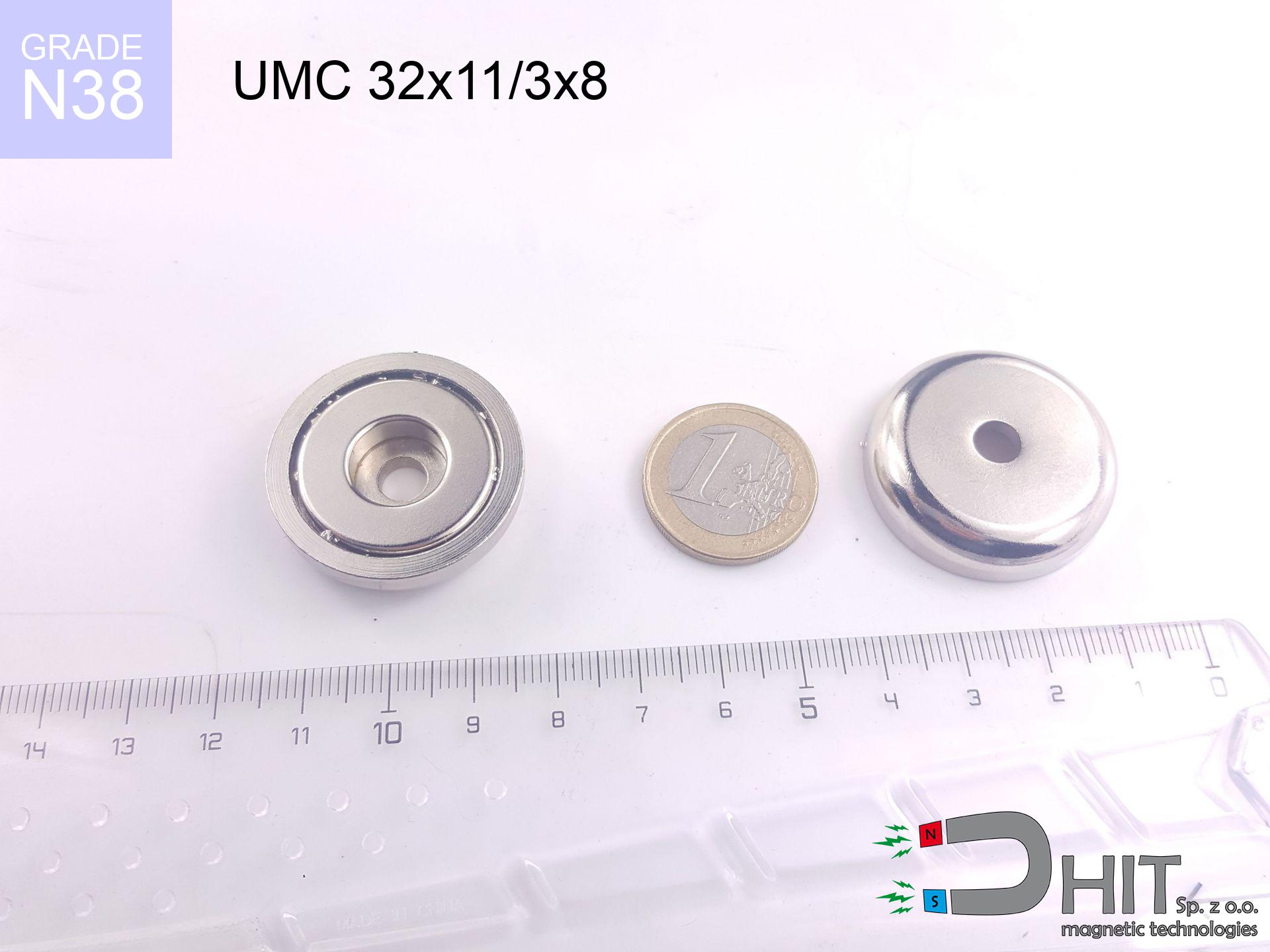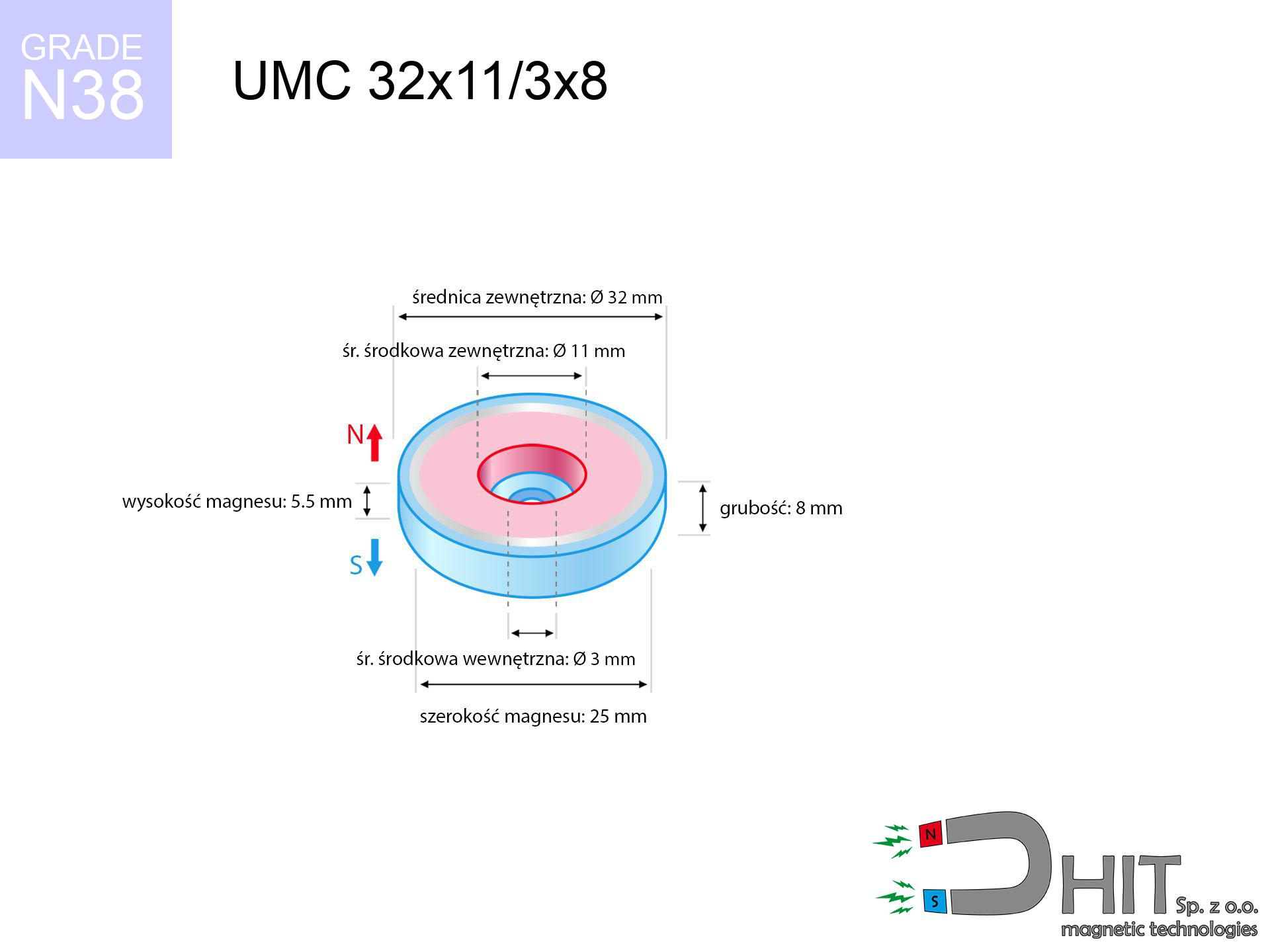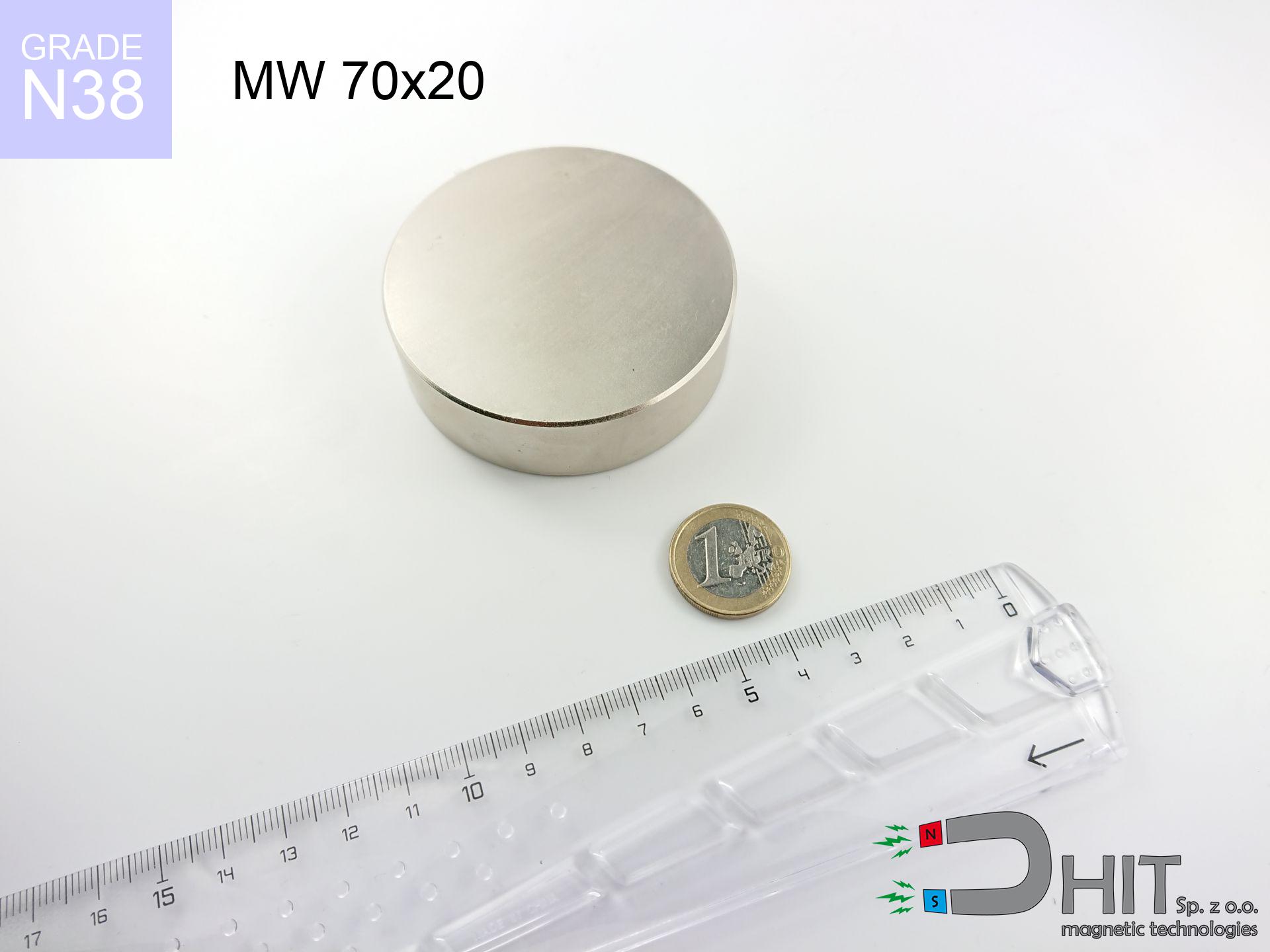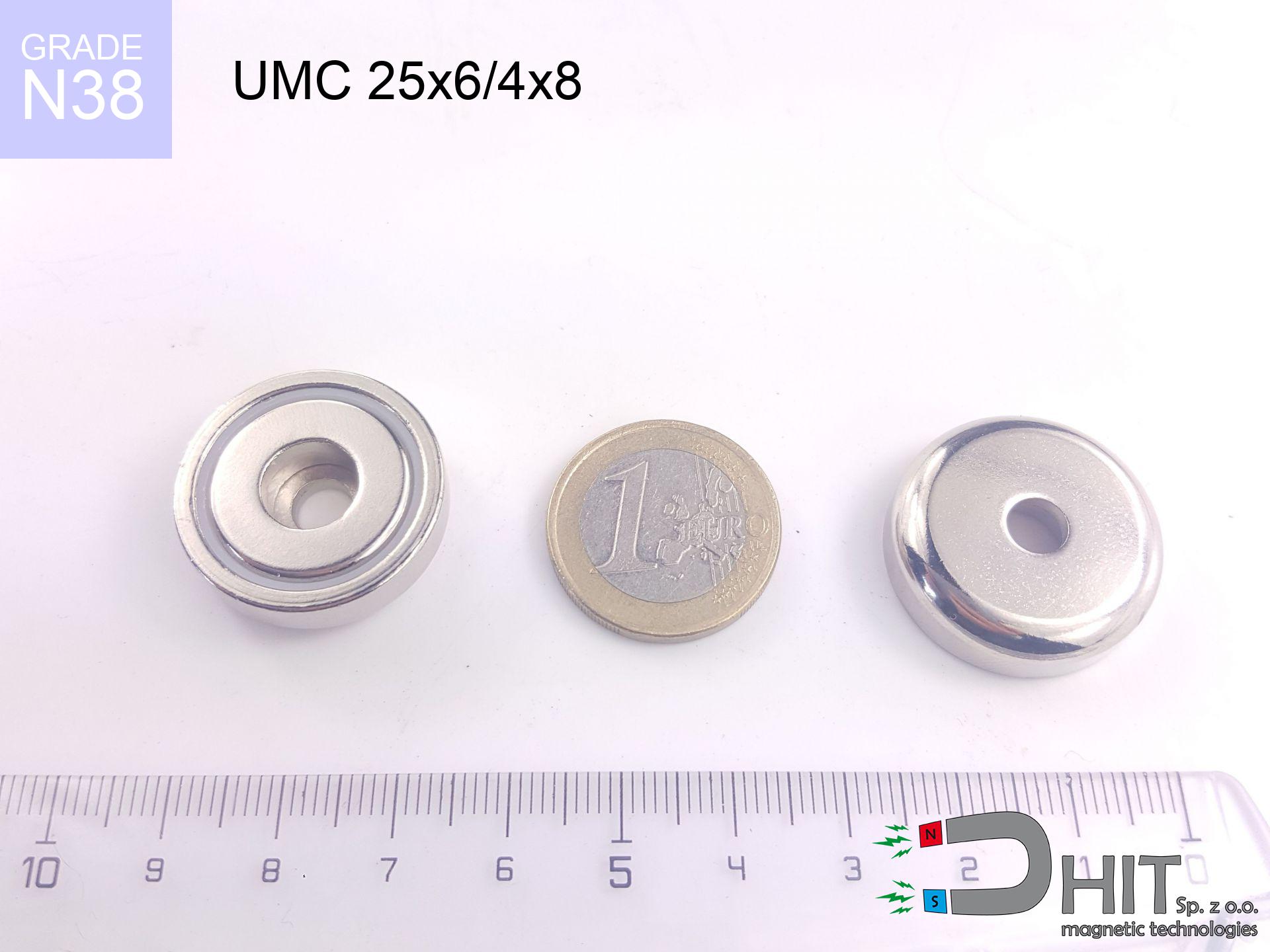UMC 32x11/3x8 / N38 - cylindrical magnetic holder
cylindrical magnetic holder
Catalog no 320409
GTIN/EAN: 5906301814658
Diameter
32 mm [±1 mm]
internal diameter Ø
11/3 mm [±1 mm]
Height
8 mm [±1 mm]
Weight
36 g
Load capacity
23.00 kg / 225.55 N
Coating
[NiCuNi] Nickel
17.98 ZŁ with VAT / pcs + price for transport
14.62 ZŁ net + 23% VAT / pcs
bulk discounts:
Need more?
Call us now
+48 888 99 98 98
otherwise let us know by means of
contact form
the contact form page.
Lifting power along with structure of a magnet can be reviewed with our
modular calculator.
Orders placed before 14:00 will be shipped the same business day.
Technical specification - UMC 32x11/3x8 / N38 - cylindrical magnetic holder
Specification / characteristics - UMC 32x11/3x8 / N38 - cylindrical magnetic holder
| properties | values |
|---|---|
| Cat. no. | 320409 |
| GTIN/EAN | 5906301814658 |
| Production/Distribution | Dhit sp. z o.o. |
| Country of origin | Poland / China / Germany |
| Customs code | 85059029 |
| Diameter | 32 mm [±1 mm] |
| internal diameter Ø | 11/3 mm [±1 mm] |
| Height | 8 mm [±1 mm] |
| Weight | 36 g |
| Load capacity ~ ? | 23.00 kg / 225.55 N |
| Coating | [NiCuNi] Nickel |
| Manufacturing Tolerance | ±1 mm |
Magnetic properties of material N38
| properties | values | units |
|---|---|---|
| remenance Br [min. - max.] ? | 12.2-12.6 | kGs |
| remenance Br [min. - max.] ? | 1220-1260 | mT |
| coercivity bHc ? | 10.8-11.5 | kOe |
| coercivity bHc ? | 860-915 | kA/m |
| actual internal force iHc | ≥ 12 | kOe |
| actual internal force iHc | ≥ 955 | kA/m |
| energy density [min. - max.] ? | 36-38 | BH max MGOe |
| energy density [min. - max.] ? | 287-303 | BH max KJ/m |
| max. temperature ? | ≤ 80 | °C |
Physical properties of sintered neodymium magnets Nd2Fe14B at 20°C
| properties | values | units |
|---|---|---|
| Vickers hardness | ≥550 | Hv |
| Density | ≥7.4 | g/cm3 |
| Curie Temperature TC | 312 - 380 | °C |
| Curie Temperature TF | 593 - 716 | °F |
| Specific resistance | 150 | μΩ⋅cm |
| Bending strength | 250 | MPa |
| Compressive strength | 1000~1100 | MPa |
| Thermal expansion parallel (∥) to orientation (M) | (3-4) x 10-6 | °C-1 |
| Thermal expansion perpendicular (⊥) to orientation (M) | -(1-3) x 10-6 | °C-1 |
| Young's modulus | 1.7 x 104 | kg/mm² |
Material specification
| iron (Fe) | 64% – 68% |
| neodymium (Nd) | 29% – 32% |
| boron (B) | 1.1% – 1.2% |
| dysprosium (Dy) | 0.5% – 2.0% |
| coating (Ni-Cu-Ni) | < 0.05% |
Ecology and recycling (GPSR)
| recyclability (EoL) | 100% |
| recycled raw materials | ~10% (pre-cons) |
| carbon footprint | low / zredukowany |
| waste code (EWC) | 16 02 16 |
View more offers
Pros as well as cons of neodymium magnets.
Advantages
- They do not lose strength, even over nearly ten years – the decrease in power is only ~1% (theoretically),
- Magnets perfectly protect themselves against loss of magnetization caused by external fields,
- Thanks to the reflective finish, the surface of nickel, gold-plated, or silver gives an visually attractive appearance,
- Neodymium magnets generate maximum magnetic induction on a small surface, which ensures high operational effectiveness,
- Neodymium magnets are characterized by extremely high magnetic induction on the magnet surface and can function (depending on the form) even at a temperature of 230°C or more...
- Thanks to modularity in designing and the ability to adapt to specific needs,
- Fundamental importance in advanced technology sectors – they are utilized in magnetic memories, drive modules, diagnostic systems, as well as other advanced devices.
- Relatively small size with high pulling force – neodymium magnets offer high power in tiny dimensions, which makes them useful in small systems
Disadvantages
- They are fragile upon too strong impacts. To avoid cracks, it is worth securing magnets in special housings. Such protection not only shields the magnet but also increases its resistance to damage
- NdFeB magnets lose force when exposed to high temperatures. After reaching 80°C, many of them experience permanent drop of strength (a factor is the shape and dimensions of the magnet). We offer magnets specially adapted to work at temperatures up to 230°C marked [AH], which are very resistant to heat
- Due to the susceptibility of magnets to corrosion in a humid environment, we advise using waterproof magnets made of rubber, plastic or other material stable to moisture, when using outdoors
- We recommend cover - magnetic holder, due to difficulties in realizing nuts inside the magnet and complex forms.
- Potential hazard related to microscopic parts of magnets pose a threat, in case of ingestion, which is particularly important in the context of child health protection. Furthermore, tiny parts of these products are able to be problematic in diagnostics medical after entering the body.
- With budget limitations the cost of neodymium magnets is a challenge,
Lifting parameters
Maximum lifting force for a neodymium magnet – what it depends on?
- with the use of a yoke made of special test steel, guaranteeing full magnetic saturation
- possessing a thickness of minimum 10 mm to avoid saturation
- with an ground touching surface
- with zero gap (no paint)
- for force applied at a right angle (pull-off, not shear)
- at temperature room level
Determinants of lifting force in real conditions
- Gap between surfaces – every millimeter of separation (caused e.g. by veneer or unevenness) diminishes the pulling force, often by half at just 0.5 mm.
- Loading method – catalog parameter refers to detachment vertically. When applying parallel force, the magnet exhibits much less (often approx. 20-30% of maximum force).
- Steel thickness – insufficiently thick plate causes magnetic saturation, causing part of the flux to be lost to the other side.
- Plate material – mild steel gives the best results. Alloy admixtures reduce magnetic properties and holding force.
- Surface condition – ground elements guarantee perfect abutment, which increases field saturation. Uneven metal reduce efficiency.
- Temperature influence – high temperature reduces pulling force. Too high temperature can permanently damage the magnet.
Lifting capacity testing was performed on plates with a smooth surface of suitable thickness, under a perpendicular pulling force, however under attempts to slide the magnet the lifting capacity is smaller. Additionally, even a slight gap between the magnet and the plate decreases the lifting capacity.
Safe handling of NdFeB magnets
Choking Hazard
NdFeB magnets are not intended for children. Eating a few magnets can lead to them connecting inside the digestive tract, which poses a direct threat to life and requires immediate surgery.
Thermal limits
Monitor thermal conditions. Exposing the magnet to high heat will destroy its properties and strength.
Caution required
Before starting, check safety instructions. Sudden snapping can break the magnet or injure your hand. Think ahead.
Risk of cracking
Watch out for shards. Magnets can explode upon uncontrolled impact, launching sharp fragments into the air. Wear goggles.
GPS Danger
An intense magnetic field negatively affects the functioning of compasses in smartphones and navigation systems. Maintain magnets close to a device to prevent breaking the sensors.
Keep away from computers
Equipment safety: Strong magnets can damage data carriers and sensitive devices (pacemakers, medical aids, timepieces).
Dust explosion hazard
Combustion risk: Neodymium dust is highly flammable. Avoid machining magnets in home conditions as this may cause fire.
Avoid contact if allergic
Nickel alert: The nickel-copper-nickel coating contains nickel. If an allergic reaction occurs, cease handling magnets and use protective gear.
Medical interference
Medical warning: Strong magnets can turn off pacemakers and defibrillators. Do not approach if you have electronic implants.
Crushing force
Mind your fingers. Two large magnets will join immediately with a force of several hundred kilograms, destroying everything in their path. Exercise extreme caution!




![SM 25x200 [2xM8] / N52 - magnetic separator SM 25x200 [2xM8] / N52 - magnetic separator](https://cdn3.dhit.pl/graphics/products/sm-25x200-2xm8-jas.jpg)




